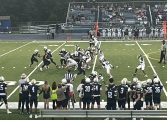This term means that the shortstop has ranged far to his right, almost behind the third baseman, to field a ground ball and throw the batter out at first. However, if the batter hits the ball through “the hole,” meaning that neither the third baseman nor shortstop could field the ball, the batter has “a seeing eye” base hit.
An old-fashioned term for a high fly out to an outfielder is “a can of corn.” A relief pitcher that comes in the late innings, or in the ninth inning only, is known as a stopper or a closer.
There are multiple slang and insider descriptions for home runs. For instance, when a batter has hit a home run it is said that he “has gone yard.” An announcer may also comment that a batter has hit 15 “dingers” so far this year, which tells the fans how many home runs he has to date.
Football has a host of technical terms and insider slang. For instance, most regular fans know what a “pick 6” is, but it is not obvious that this refers to a pass interception that is returned for a touchdown (six points). Similar to “going yard,” the expression “taking it to the house” in football means a long run for a touchdown. It is an odd term, but even most casual fans know that “a sack” occurs when the quarterback is tackled behind the line of scrimmage.
In basketball a shooter is said to have made his basket from “the top of the key,” from “the elbow,” or even from “in the paint.” These take a little explaining.
The “paint,” or the lane, is the area between the foul line and the baseline, which is the out of bounds line under the basket. On most basketball courts this rectangular area is painted a different color than the rest of the court, hence the term “in the paint.” Behind the foul line there is a semicircle. In the distant past, the painted area on a court was narrower than the foul line, so the painted area, the foul line and the semicircle behind it looked like an old-fashioned key hole. Therefore, a shot from the top of the semicircle behind the foul line is “from the top of the key.” The “elbow” is the right angle, like an elbow, formed by the foul line and the line to the baseline.
In basketball when a player soars high enough to slam the ball down through the basket he has made a “dunk shot,” or more recently, he has “flushed the ball.” Three-point shots are often referred to as “from downtown.”
A “screen” in basketball is when an offensive player without the ball stands still and his teammate dribbles past him, so that the player defending the dribbler is run into the “screen.” If the player setting the screen moves, it is an “illegal screen.”
In soccer a score of zero is almost always referred to as “nil.” In tennis zero is “love.”
In hockey a team is penalized for “icing the puck.” This means the team on defense has shot the puck all the way down the ice to the other end without anyone touching it.
In soccer, hockey and football, players can be “off-side.” The term has a slightly different meaning in each sport, but the general principle is that the player that is off-side has put himself into an advantageous position that is not allowed.
A golfer who is suddenly having problems with his putting is said to have “the yipps.” Also in golf, if a drive curves badly to the right for a right-handed player it is “a slice,” if it goes badly left it is “a hook.” If a ball moves right in a more controlled way it is a “fade.” And if it moves left in a more controlled way it is a “draw.”
There are actually glossaries available online with hundreds of terms defined for most major sports.




